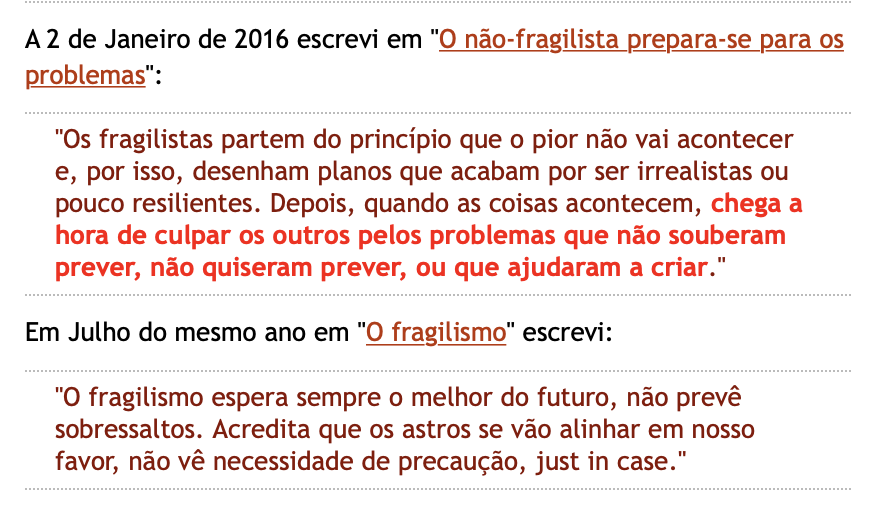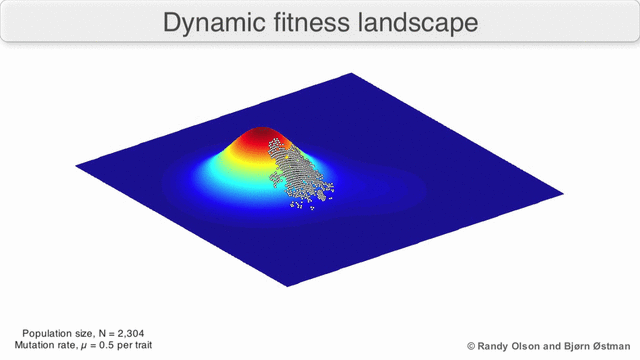Qualquer negócio, do maior ao mais pequeno, está representado na figura acima. Qualquer negócio só tem direito à existência se conseguir atrair e manter uma plateia com "peso" suficiente para o sustentar e impedir que caia no abismo.
Uma plateia, qualquer plateia é composta por vários tipos de intervenientes - um ecossistema. No entanto, os mais importantes, os mais "pesados", são os que pagam pela oferta, são os clientes.
Os clientes não são todos iguais. Há clientes que valorizam sobretudo o preço, há clientes que valorizam sobretudo o serviço feito à medida e há clientes que valorizam sobretudo algo inovador ou diferente.
Quando falamos de leite, aprendi há muitos anos, falamos da
commodity alimentar por excelência:
"Milk is the ultimate low-involvement category, and it shows. Only 10% of the international sample (in Denmark, Germany and Spain the number is less than 5%) would expect the private label version to be of a lesser quality."
Vender leite é um negócio de preço. Qualquer negócio de preço é um negócio de eficiência, é um negócio de volume. Recordemos
Marn e Rosiello:
Se o negócio é preço o modelo rola à base disto:
Neste postal recente, "
O que mais ninguém lhe conta (parte II)" contei o caso de uma vacaria em Portugal com cerca de mil vacas, quando o tamanho médio das vacarias rondava há uns anos as 30 vacas. Na parte I desse postal perguntava:
Como é que num negócio em que o que conta é o preço (logo o custo), uma exploração com 30 vacas, ou 50 vacas, pode competir com uma de 500 ou de 900 vacas? (900 é só o número médio)?
Na parte I desse postal admirava-me com um vacaria americana com 9 mil vacas. Neste postal de 2012, "
A verdade que não nos é contada, acerca do leite" citei uma breve referência a uma vacaria que teria 30 mil vacas:
"One farm in Indiana has 30,000 cows, and is a tourist attraction, with its own off-ramp on the interstate."
Como é que num negócio em que o que conta é o preço (logo o custo), uma exploração com 900 vacas, pode competir com uma de 30 mil vacas?
Se optarem pela concorrência perfeita não podem ponto! Por isso, metem os políticos ao barulho e nasce o pernicioso
activismo político associado ao leite.
Se o negócio é preço não há mistério, como diria Roger Martin. Se o negócio é preço não há arte, há ciência,
há algoritmo:
Se o negócio é preço a abordagem a seguir é a do pragmatismo que me surpreendeu na altura. As formigas no piquenique em, "
Faz sentido continuar a apostar num negócio?" (Julho de 2006).
Daí não ser de espantar esta
evolução:
"Em 25 anos (entre 1989 e 2013) desapareceram 90 mil explorações e reduziu-se o efetivo animal em mais de 140 mil vacas leiteiras, o que corresponde a variações negativas de, respetivamente, 92,2% e 34,7%.
Esta evolução traduziu-se sobretudo na eliminação de explorações pecuárias com um número reduzido de efetivos e consequente aumento da dimensão média dos efetivos por exploração (de cerca de 4 vacas por exploração para aproximadamente 34 vacas por exploração)."
Ontem à noite, ao folhear a Bloomberg Businessweek do próximo dia 2 de Março comecei por apanhar uma foto que me fez recordar a tal vacaria portuguesa com cerca de 1000 vacas:
Em "
The Dairy Farm of Your Imagination Is Disappearing" encontrei a tal vacaria com 30 mil vacas que referi no postal de 2012 citado acima:
"This is Fair Oaks Farms, an Indiana tourist attraction designed to entertain road-weary families and deliver them back to the highway reassured that American agriculture is headed in the right direction. With more than 33,000 cows that pump out some 300,000 gallons of milk daily, it’s also quite a bit more.
...
In Wisconsin alone, between two and three family dairy farms go out of business every single day. (Some of these farms still operate, but no longer as dairies.) That rate has held steady for about three years, which is particularly striking given how few farms remain left to fail. In the early 1970s, the state had more than 75,000 dairies. Today it has about 7,400.
...
Half of Minnesota’s dairy farmers failed to break even for the year. There, too, thousands of dairy farms have simply vanished.
.
In the midst of this mass extinction, a counterintuitive fact remains true: Americans are consuming more dairy products than ever before, primarily because yogurt and cheese have compensated for a steady drop in fluid milk consumption. Americans consumed 646 pounds of dairy per person in 2018—the highest consumption rate in 56 years.
...
As small farms fold, the balance of production tilts further toward huge, efficient, industrial dairy operations that can more easily weather price downturns and manage a razor-thin profit margin through the power of scale.
...
“Thirty years ago, when I got started, if you would have asked me what a large farm was, I probably would have said 15 or 20 cows, [Moi ici: Conseguem imaginar a vertigem da evolução durante estes 30 anos?]
/https%3A%2F%2Fassets.bwbx.io%2Fimages%2Fusers%2FiqjWHBFdfxIU%2FiSqK0NAaKoa4%2Fv0%2F-1x-1.png) [Moi ici: Comparar com Portugal]
[Moi ici: Comparar com Portugal]
 ...
...
Today, more than 53% of America’s milk is produced by less than 3% of its farms. That helps explain how, in the face of a massive reduction in the number of total dairies, the U.S. continues to produce more milk and cheese than the market consumes—in 2019, America’s cheese surplus reached 1.4 billion pounds.
...
“Now, what we see, obviously, is economies of scale having happened in America—big get bigger, and small go out,” Perdue said. “I don’t think in America we, for any small business, have a guaranteed income or a guaranteed probability of survival.” Maybe he was just stating a hard truth, but to a farmer like Yager, it sounded as if the architects of the U.S. dairy industry had all but agreed on a shared assumption: Small farms are destined, sooner or later, to fail.
...
“Every time you come up with a plan to maybe make things better, I just feel like there’s someone who’s already a step ahead of you,” Yager says. “So what do you do?” [Moi ici: Competir no negócio do preço é estar sujeito ao efeito da Rainha Vermelha. Correr, correr, correr desalmadamente para conseguir ficar no mesmo sítio]
.
A lot of people go out of business.
...
“There’s got to be something other than saying, ‘Well, you have to be big to survive,’ ” he says. [Moi ici: Reacção típica de quem apenas conhece uma alternativa e julga que todos os clientes são iguais e valorizam as mesmas coisas. Recordo dois exemplos franceses aqui e aqui. Recordo um exemplo inglês com leite biológico completo e a aposta na diferenciação] “Maybe this is getting a little radical, but it reminds me of medieval times. Like we’re going back to that. We’ll have our kings—the owners, the corporations—and then we’ll have all the people who work the land. That didn’t work well centuries ago. Because taking ownership, taking pride—that’s what makes things really work. We’re gonna lose that. And think about conservation. Think about water quality. I don’t think you find land conservation, water quality, and animal care any better, anywhere in the world, than you do on these family farms. You absolutely will not!”
...
Amid all that angst, some farmers have found a way to profit on smallness itself.[Moi ici: Malta do calçado, estão a ver o exemplo?]
.
Paul Aubertine grew up on a plot of land overlooking the St. Lawrence River on the northern edge of New York state, near Cape Vincent. He was poised to be the seventh generation of his family to take the reins of the 50-cow dairy farm, but in 2002 his father and grandfather determined they couldn’t keep the business afloat any longer. Aubertine went to college, pursued a career in sales, and started a family.
.
The older he got, the more he recognized and valued all that had been lost. There’d been 35 or 40 dairies in the community when he was growing up; now, wracking his brain, he could come up with four. “I really wanted my kids to experience what I’d experienced, to give them the chance to grow up on a farm and be exposed to the same thing,” he says.
.
He and his brother-in-law, a computer scientist, decided in 2015 to restart the dairy. They crunched the numbers and saw that trying to compete with the 1,000-cow mega-dairies on their terms was a recipe for disaster. “I’ve never had an interest in having employees, and $300,000 tractors, and all the other stuff you need for that,” says Aubertine, who’s now 37. Instead, they decided to produce milk that could be certified as grass-fed and organic. Their cows would graze in the field. Aubertine would buy no herbicides, no grain feed, no nutritional supplements, no hormone treatments. Instead of acquiring the huge, high-powered heifers that produce 90 pounds of milk a day, he assembled a herd of smaller cows that might give him 35. Because of the animals’ reduced stress, he could keep them on the farm longer, saving on livestock costs.
.
“I’m a realist, and I expected bumps on the road, but—and I shouldn’t say this out loud, probably—but it’s been beyond my expectations, what we’ve been able to do,” Aubertine says. The price he commands for grass-fed organic milk isn’t double that of regular milk, but it’s close, and his expenses are a fraction of what a modern dairy would require. He can raise his kids, take them on vacations, buy nice things, and preserve precisely the things about dairy farming that he believed were worth preserving."


























/https%3A%2F%2Fassets.bwbx.io%2Fimages%2Fusers%2FiqjWHBFdfxIU%2FiSqK0NAaKoa4%2Fv0%2F-1x-1.png)











